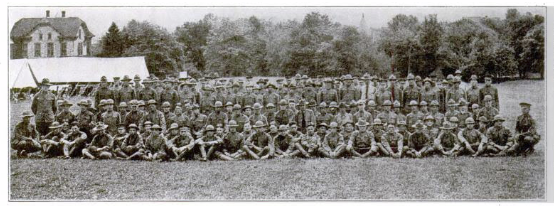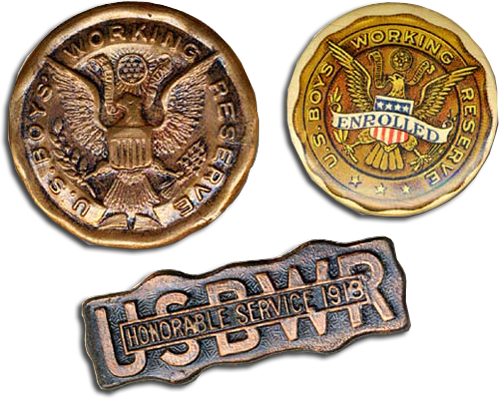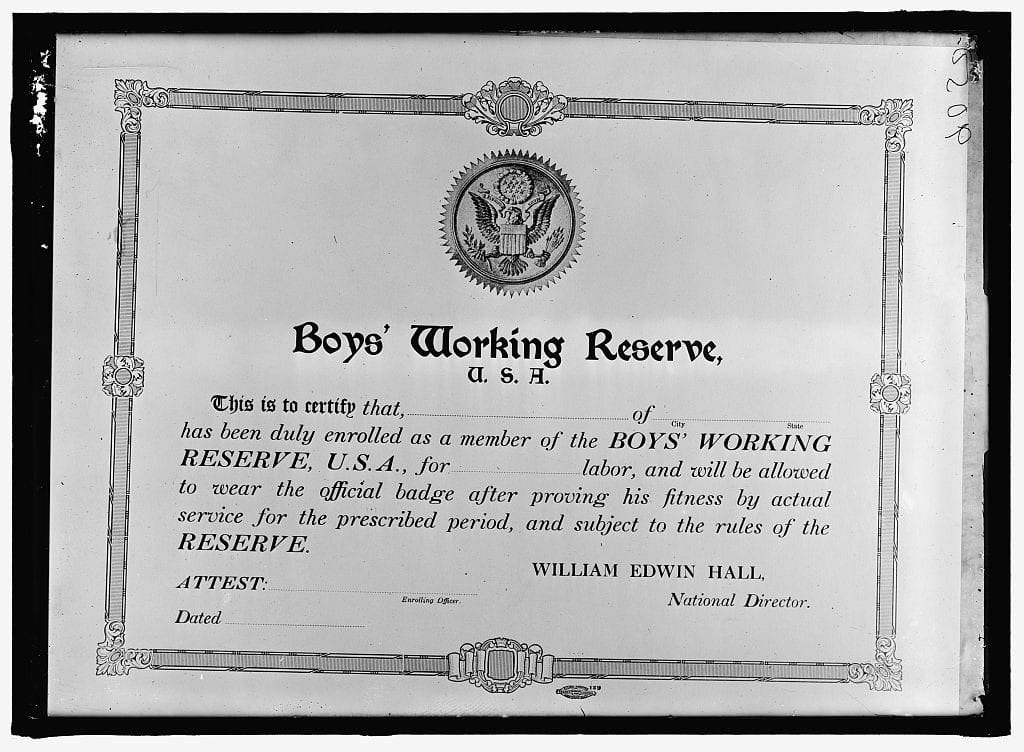| “Down on the Farm” could refer to the 1994 Tim McGraw hit song. It could also refer to the 200,000 boys during World War I who volunteered to serve in the U. S. Boys Working Reserve and go to work “Down on the Farm.”
During World War I there was an acute shortage of people to work on farms. Many of the farmers and young men had set down their hoes and shovels and picked up rifles and marched off to war. Today we are looking at one of the approaches used to address the farm labor problem during WW I – the U. S. Boys Working Reserve.

The June 1917 issue of the Monthly Review of the U.S. Bureau of Labor Statistics described the formation of the United States Boys Working Reserve. The purpose of this program (p. 991) was “to meet the labor shortage in certain industries, notably farming, by squads of boys, properly supervised and well cared for, who will work during their vacation periods or longer at a fair and predetermined wage.” This program was a joint venture of the United States Department of Agriculture and the Department of Labor, with Labor being the lead agency.
A brochure about the program produced by the Department of Labor stated the “purpose is to mobilize for productive service, chiefly on our farms, all physically fit American boys from 16 to 20 years of age; to see their education is maintained; and to prevent any exploitation of their labor.” (U.S. Department of Labor, p. 4).

There was a national director of the program whose office was in Washington in the Department of Labor. Each state had a “Federal State Director of the Boy’s Working Reserve”. A number of the early pioneers in school-based agricultural education, vocational education, and the extension service served as state directors (see the list of state directors on pages 14 & 15 in the Booklet of Information). David Snedden was the Director for New York. O. H. Benson, a national 4-H leader served on the National Advisory Committee.
Boys had to be between 16 to 20 years of age to enroll. They had to pass a physical exam and have the written consent of a parent or guardian to join the Working Reserve. There was an “Enrolling Officer” in every high school and public library in the United States. Click here to see the application form.
By November of 1918, there were over 200,000 boys enrolled in the Reserve from Maine to California. There were Farm Training Camps for the boys. These camps were conducted by state agricultural colleges, county agricultural schools or local high schools. The boys learned how to perform various farm tasks. Some of the first training camps were at the University of Colorado, University of Connecticut, Purdue, University of Nevada, Vermont School of Agriculture, the Winthrop Center in Maine. and Penn State. The photo below is of the fourth Farm Training Camp conducted at Penn State.

Camp Vail, located on the campus of the Vermont School of Agriculture was a two-week long camp. Groups of 50 boys attended this camp. They slept in tents and were awaken by a bugle. After morning exercises, they marched to breakfast and then learned agricultural skills in groups of ten. The boys learned haying, dairying, care of horses, woodcutting, truck gardening, and other skills. They were also taught about the importance of having a good work ethic.
If the boy could not attend a training camp, the Department of Labor produced a series of Farm Craft Lessons. The author of the Farm Craft Lessons was Eugene Davenport, Dean of Agriculture at the University of Illinois. These Farm Craft Lessons were distributed to high schools where students could study them. Click here to access the lessons.

After training, boys were placed on farms. County agents often assisted the local enrolling officer in the placements. It was acceptable to work on your home farm. Several states had forms that farmers completed to request the workers.
Farmers at first were skeptical, especially when boys were drawn primarily from large cities. However, the boys proved they could do the work. Of 562 boys from Chicago in the Reserve, 559 were rated as satisfactory by their employers. The percentage of failures in the program was less than two percent.
Typically, the boys were paid a dollar a day and provided food and lodging. If the boy could drive a tractor, the wage was higher. Sometimes the farmer hired a group of boys, and at other times a single boy.
When a boy enrolled in the Reserves, he received a button showing that he had enrolled (top right below) After working 300 hours he was awarded a bronze service badge with the inscription “Boy’s Working Reserve, U.S.A.” If the boy worked the entire summer, he was awarded a bar with the inscription “Honorable Service.” It was expected the work would occur during the summer [Note: A future Footnote will look at the New York state Farm Cadet program where high school students were allowed to work during the spring semester of school, receive full academic credit and be excused from the state exam].

There was an optional National Reserve Uniform that the boy could buy for $10. This was not required but encouraged. The photo below shows a boy in his uniform.

After the success of the “Agricultural Unit”, an “Industrial Unit” was formed to meet the labor needs in various trades and industries. There was also a “Vocational Training” Unit. The Department of Labor published a newsletter titled “Boy Power” for those involved with the program. There are all types of interesting notes and news in the publication which can be viewed here.
The U. S. Boys’ Working Reserve program helped win the war by producing food for the nation and our allies abroad. It is also showed the value of vocational education. Since the Smith-Hughes Act was passed in the same year the Boy’s Working Reserves was established, the Reserves program may have opened the eyes of school administrators who were uncertain about establishing vocational education programs in their schools.

Teaching Ideas:
If you teach a unit on the history of agriculture, you might include some content about the U. S. Boys’ Working Reserve. You could also draw the connection between the Reserves and SAE. Just as students today can earn proficiency award medals, students in the reserves also received medals. You could have students determine what type of SAE the boys in the Working Reserves experienced. It might be interesting to share some of the Farm Craft Lessons and have your students determine if those lessons would be appropriate today. The audio interview of a Reserve boy (see below) could also be played.
References:
Hatton, R. (1918, November). The First 200,000 in the Boy Army. The Rotarian. Volume 13, Number 5, p. 210.
U. S. Department of Labor, Booklet of Information, U. S. Boys Working Reserve.
Valz, Dino – Transcript of an interview about his experience at Camp Vail in Vermont.
World War I: Camp Vail – https://vermonthistory.org/research/research-resources-online/green-mountain-chronicles/world-war-i-camp-vail-1916 (This site contains a 4-minute audio interview with Dino Valz). |